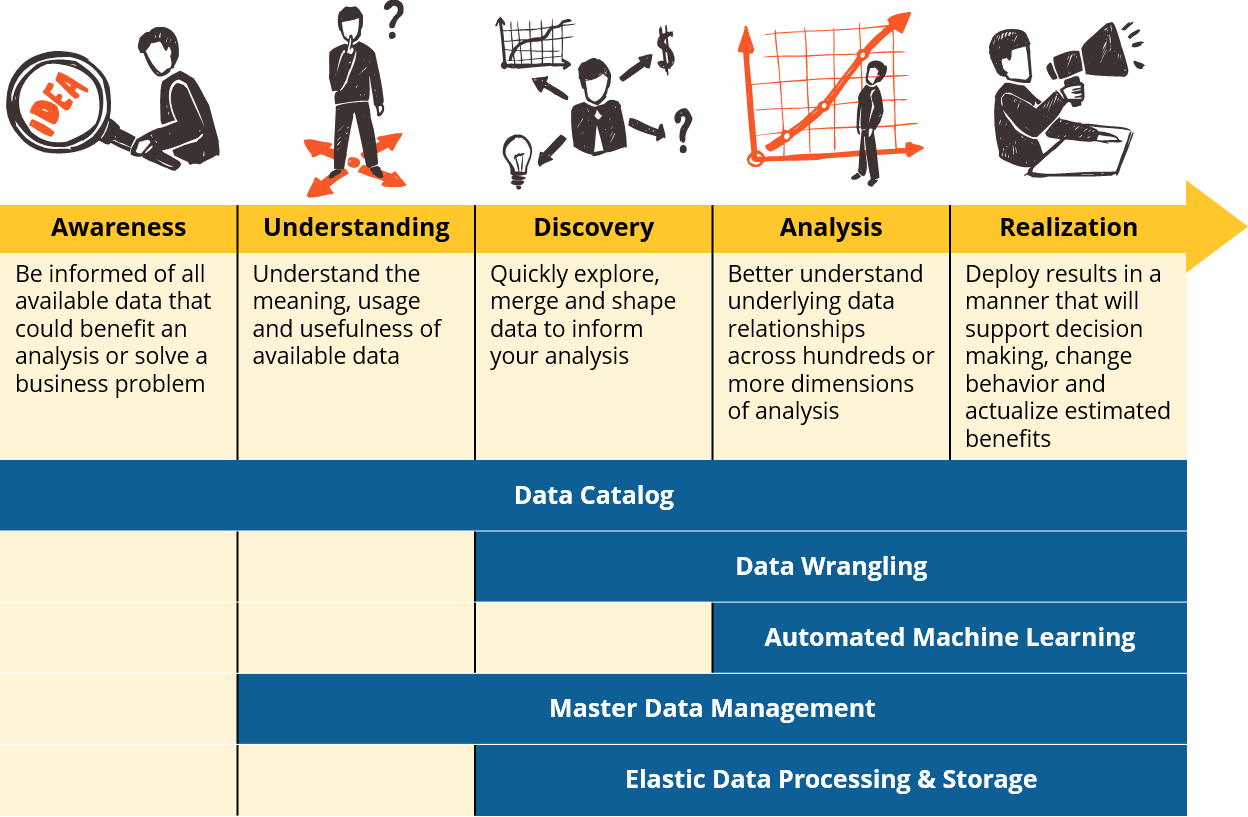Five Essential Capabilities of the Competitive Data-Driven Enterprise
If your organization is seeking to better manage its information as a corporate asset that is to be valued and capitalized, you’re likely focused on implementing programs that will catalyze measurable business results from mountains of business information that may be the product of the last decade or more of digital transformation initiatives.
A preferred approach to beginning this journey is to survey the organization, build a prioritized roadmap of business use cases, and then systematically deliver new decision support applications that will make the business smarter and effect measurable improvements. This is a pragmatic approach to creating value (it’s arguably the best way to prime your program), but in order to truly alter the culture and long-term disposition of the organization to being data-driven, we must also use this process to enable a powerful partner in our pursuit of data monetization: the citizen analyst.
The Self-Service Imperative
As a centralized organization building applications on behalf of our stakeholders we will eventually become a bottleneck to business innovation, but if we can simultaneously enable everyone in our organization to independently ask better questions and use all of our available data to produce more insights, then we will have truly enabled a self-sustaining data-driven enterprise.
The concept of empowering business domain experts to solve their own problems is not new, but there are three major forces in play that have made this more feasible, if not an inevitability for most businesses:
- The proliferation of user-friendly technology that simplifies or automates complex data analysis tasks through intuitive interfaces
- The accessibility of online and apprenticeship-style learning programs to up-skill existing employees
- Shifting workforce demographics where new entrants continue to be more technically savvy and data literate than preceding generations
To activate this army of data value hunters who are flush with their own ideas on how to measure and improve the business, we need to provide them with the skills and tooling that will enable them to do so independently. As a centralized advisor to the business, our sphere of influence and control can be limited, but there are still plenty of levers that we can pull to support our objective. Just as the prospects for a bountiful harvest would be greater in a climate-controlled greenhouse than in a barren desert, we should seek to cultivate an environment where more knowledge workers can simultaneously answer more questions from data and do so in increasingly shorter cycle times.
Lowering the Time and Cost to Analyze
If we can optimize for one performance metric in this pursuit it would be the time or cost to analyze. This is the time it takes a citizen analyst to traverse the data analysis process from a business hypothesis to a meaningful conclusion (either positive or negative). Shortening this time will not only massively benefit productivity but will create more business opportunity. Analysts will be more likely and able to quickly to experiment and test new ideas without the innovation-stifling risk of lost time on fruitless pursuits.

By modeling a common business or data analyst’s journey, we are able to shine a light on five essential capabilities for a data-driven business seeking to be competitive in their environment, create scale in their ability to do business analytics, and continually lower their cost per unit of analysis:
- Data Catalog
- Data Wrangling
- Automated Machine Learning
- Master Data Management
- Elastic Data Processing & Storage
Some of these would be classified as emerging, such as automated machine learning, and others like master data management, are established concepts which due to advances in machine learning now have an enhanced value proposition that warrants a reevaluation. We also recognize that there are many other well-studied and ubiquitous capabilities such as data visualization or data warehousing. This list is by no means meant to be exhaustive, but rather focus on the citizen analyst and the contemporary concepts we can deploy to best enable this large and often underutilized corporate resource. These five capabilities will also serve to amplify the usefulness and ROI of your existing investments in analytics.
Generating Data Awareness and Understanding
Let’s begin our exploration where most business analysts would start: data awareness. In today’s modern enterprise, with so much data diversity and volume, most analysts and domain experts aren’t even aware of the breadth of data they could tap into to power their analysis. Even if they are, they may lack the necessary data understanding to fully unlock its usefulness or prevent costly mistakes. The data catalog is quickly emerging as an empowering, agile and insightful form of data governance that is shortening analytical cycle times, creating new business opportunities, and shining a spotlight on the deepest and darkest corners of an organization’s institutional knowledge for others to learn and benefit.
About Ironside
Ironside was founded in 1999 as an enterprise data and analytics solution provider and system integrator. Our clients hire us to acquire, enrich and measure their data so they can make smarter, better decisions about their business. No matter your industry or specific business challenges, Ironside has the experience, perspective and agility to help transform your analytic environment.





